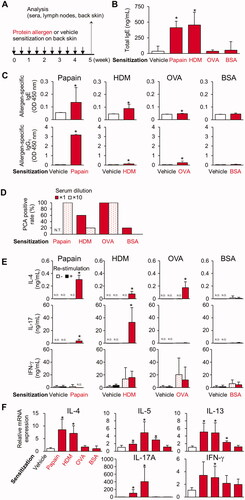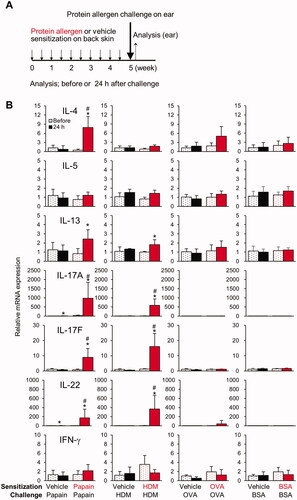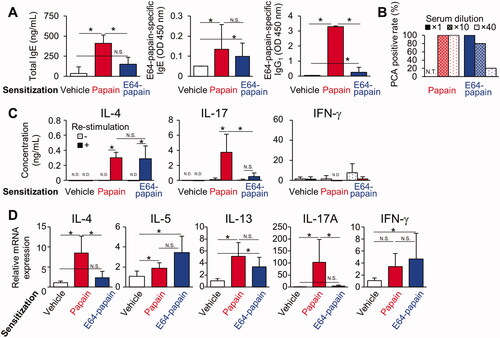Figures & data
Figure 1. Epicutaneous sensitization with papain, HDM, and OVA, but not with BSA, on the back skin of mice induces serum allergen-specific IgE and IgG1, and differentiation of TH2 cells. (A) Timeline. (B) Serum total IgE. (C) Serum allergen-specific IgE and IgG1. (D) Positive PCA reaction rates. (E) Cytokine production in DLN cells re-stimulated with protein allergens. (F) Gene expression in back skin. Data shown are means ± SD of 5 mice/group representing two independent experiments with similar results. *p < 0.05 vs. vehicle (B, C, F) or no re-stimulation (E) by Mann-Whitney U test. N.D.: not detected; N.T.: not tested.

Figure 2. Epicutaneous challenge with papain and HDM, but not with OVA and BSA, on the ear skin stimulates TH2 and TH17/TH22 cytokine gene expression dependent upon epicutaneous pre-sensitization. (A) Timeline. (B) Gene expression in ear skin before and 24 h after challenge. Data shown are means ± SD of 4 mice/group and represent two independent experiments with similar results. *p < 0.05 vs. before challenge, #p < 0.05 vs. vehicle (Mann-Whitney U test).

Figure 3. Epicutaneous papain sensitization accelerates serum antibody production and differentiation of TH17 cells dependent on protease activity. (A) Serum antibodies. (B) Positive PCA reaction rates. (C) Cytokine production in DLN cells re-stimulated with E64-papain. (D) Gene expression in back skin. Data shown are means ± SD of 5 mice/group representing two independent experiments with similar results. *p < 0.05 by Mann-Whitney U test. N.D.: not detected; N.T.: not tested.

Data availability statement
The data that support the findings of this study are available from AO upon reasonable request.
